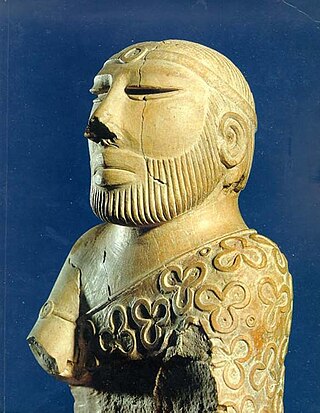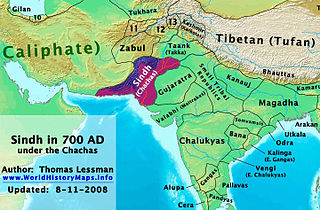Related Research Articles

Makran, also mentioned in some sources as Mecran and Mokrān, is the southern coastal region of Balochistan. It is a semi-desert coastal strip in the Balochistan province in Pakistan and in Iran, along the coast of the Gulf of Oman. It extends westwards, from the Sonmiani Bay to the northwest of Karachi in the east, to the fringes of the region of Bashkardia/Bāšgerd in the southern part of the Sistan and Baluchestan province of modern Iran. Makrān is thus bisected by the modern political boundary between Pakistan and Iran.

Muḥammad ibn al-Qāsim al-Thaqafī was an Arab military commander in service of the Umayyad Caliphate who led the Muslim conquest of Sindh, inaugurating the Umayyad campaigns in India. His military exploits led to the establishment of the Islamic province of Sindh, and the takeover of the region from the Sindhi Brahman dynasty and its ruler, Raja Dahir, who was subsequently decapitated with his head sent to al-Hajjaj ibn Yusuf in Basra. With the capture of the then-capital of Aror by Arab forces, Muhammad ibn al-Qasim became the first Muslim to have successfully captured Indian land, which marked the beginning of Muslim rule in South Asia.
Lohana are a trading or mercantile jāti mostly in India and also in Pakistan.
The Rai dynasty was a polity of ancient Sindh. All that is known about the dynasty comes from the Chach Nama; recent scholarship has tried to corroborate the existence of the dynasty from contemporary coin finds but such attempts remain speculative and unconvincing.

The history of Balochistan refers to the history of the Balochistan region of Pakistan, Iran and Afghanistan. Vague allusions to the region were found in Greek historical records of around 650 BCE. Prehistoric Balochistan dates to the Paleolithic.
Chach Nama, also known as the Fateh nama Sindh, and as Tareekh al-Hind wa a's-Sind, is one of the historical sources for the history of Sindh and it was written in 13th century by Ali Kufi.
The Samma dynasty was a medieval Sindhi dynasty which ruled the Sindh Sultanate from 1351 before being replaced by the Arghun dynasty in 1524.
Raja Dahir was the last Hindu ruler of Sindh. A Brahmin ruler, his kingdom was invaded in 711 CE by the Arab Umayyad Caliphate, led by Muhammad bin Qasim, where Dahir died while defending his kingdom. According to the Chachnama, the Umayyad campaign against Dahir was due to a pirate raid off the coast of the Sindhi coast that resulted in gifts to the Umayyad caliph from the king of Serendib being stolen.
Chach was a Hindu Brahmin king of Sindh region of the Indian subcontinent in the mid-7th century AD. Chach expanded the kingdom of Sindh, and his successful efforts to subjugate surrounding monarchies and ethnic groups into an empire covering the entire Indus valley and beyond were recorded in the Chach Nama.
Hyderābād City (Haidarābād), headquarters of the district of Sindh province of Pakistan traces its early history to Neroon, a Sindhi ruler of the area from whom the city derived its previous name, Neroon Kot. Its history dates back to medieval times, when Ganjo Takker, a nearby hilly tract, was used as a place of worship. Lying on the most northern hill of the Ganjo Takker ridge, just east of the river Indus, it is the third largest city in the province and the eighth largest in the country with an expanse over three hillocks part of the most northerly hills of the Ganjo Takker range, 32 miles east of the Indus with which it is connected by various routes leading to Gidu Bandar.
Nasir al-Din Abu al-Fatah Firuz Shah II, commonly known as Jam Feroz (1508–1524/5), was the last ruler of the Samma dynasty of Sindh. Jam Feroz proved himself a weak ruler and lost his kingdom to Arguns, thus Sindh came under foreign rulers.

Mansura, referred to as Brahmanabad in later centuries, was the historic capital of the caliphal province of Sindh, during the eighth century under the Umayyad Caliphate and then Abbasid Caliphate from the year 750 AD to 1006 AD. The city was founded as a central garrison by the Umayyad Forces in Sindh, the city transformed into a very vibrant metropolis during the Abbasid Era surpassing the wealth of Multan in the north and Debal in the south. Mansura was the first capital established by the Muslims in the Indian subcontinent after Muhammad bin Qasim seized the Brahmanabad territory. Mansura was built on the shores of the Indus River, it was surrounded by fertile farmland, Ibn Hauqal mentioned the wealthy local merchants who wore Baghdad Costume and were of Sindhi-Arab origins, houses were made of clay, baked bricks and plaster.
Agham Lohana was the powerful king of Brahmanabad, contemporary and opponent to Chach of Alor. Agham was a Buddhist and belong to Lohana clan.
Siharas was the Rajput king of Kannauj in the 7th century CE.
Chandra or Chandar was a Brahmin ascetic who succeeded his brother, Chach of Alor, as king of Sindh region of the Indian subcontinent. An account of Chandar's reign is presented in the Chach Nama, a recording of this period of Sindhi history and the broader history of the Indian subcontinent.

The Brahmin dynasty of Sindh, also known as the Chacha dynasty, was the ruling dynasty of the Sindh, succeeding the Rai dynasty. Most of the information about its existence comes from the Chach Nama, a historical account of the Chach-Brahmin dynasty.

On 16 February 2017, a suicide bombing took place inside the Shrine of Lal Shahbaz Qalandar in Sehwan, Sindh, Pakistan, where pilgrims were performing a Sufi ritual after the evening prayers. At least 90 people were killed and over 300 injured.

The Umayyad conquest of Sindh took place in 711 AD against the ruling Brahmin dynasty of Sindh and resulted in Sindh being incorporated as a province into the Umayyad Caliphate. The conquest resulted in the overthrow of the last Hindu dynasty of Sindh, the Brahman dynasty, after the death of Raja Dahir.
Surya Devi, was an Indian Hindu Princess of Sind. She is known for having been the war booty of the Umayyad army commander Muhammad bin Qasim during the Umayyad conquest of Sindh and given along with her sister as slaves to Caliph Sulayman ibn Abd al-Malik. According to the traditional story, she persuaded the Caliph to execute Muhammad bin Qasim, avenging her parents, and then managed to escape the captivity of the harem by having the Caliph execute her and her sister.

The Battle of Aror took place in 711 AD between the Umayyad forces under Muhammad ibn al-Qasim and the army of Brahmin dynasty of Sindh under Raja Dahir. It was the last military conflict of Raja Dahir, in which the Umayyads defeated his army near Indus river and resulted in the death of Dahir.
References
- ↑ "Rajput" meaning one of the many, patrilineal ruling clans of northern India and some parts of Pakistan
- ↑ Nabi Khan, Ahmed (1997). Studies in Islamic Archaeology. Sang-e-Meel Publications. p. 165.
- 1 2 "Chach sends a messenger to Akham Lohána, chief of Brahmanábád", from the Chach Nama , in Elliot, Henry Miers (1867), The History of India, as Told by Its Own Historians. The Muhammadan Period , Vol. I, edited and continued by J. Dowson (London: Trübner), pp. 145–146.
- 1 2 3 "The army marches to Siwistán", from the Chach Nama , ibid., p. 145.
- ↑ Department of Modern Indian History (1965). Journal of Indian History. 43. Universities of Allahabad, Kerala, and Travancore: 377.
{{cite journal}}: Missing or empty|title=(help) - ↑ Centre for the Study of the Civilizations of Central Asia (1979). Journal of Central Asia. 2 (1). Quaid-i-Azam University.
{{cite journal}}: Missing or empty|title=(help) - 1 2 "Journey of Matta, Chief of Siwistán", from the Chach Nama , ibid., p. 153.
- ↑ "The answer of Siharas", from the Chach Nama , ibid., p. 153.